City of Warrnambool Rowing Club – 140 years on the Hopkins River
By Susan Finnigan
- Acknowledgements
- Foreword
- 1: Inception to shed
- 2: 1890 - World War One
- 3: War to War
- 4: Peace, Olympics, alcohol, tragedy, a new shed and a few wins
- 5: Centenary celebrated, State Champions off to the Nationals
- 6: Moving along the bank
- 7: Masters and schools row through the wilderness years
- 8: Rowing on
- Life Members
- Presidents and Vice-Presidents: 1870-2015
- Committee: 1870-2015
- Committee: Warrnambool Ladies Rowing Club, 1911-1937
Chapter Three: War to war.
On August 4 1914 World War One started and young men left to join the fighting. The Club was about to feel the ramifications of this exodus. The Victorian Rowing Association had sanctioned the Club to hold a regatta on Boxing Day instead of Foundation Day and plans were discussed at a public meeting in the Council chambers. 79 80 81 Correspondence tabled included a letter of support from the Warrnambool Ladies’ Rowing Club ‘promising support’ for the regatta. At the meeting it was ‘reluctantly’ decided to cancel the regatta and the Club adjourned for 12 months. 82 83
The Warrnambool Ladies’ Rowing Club however had a positive start to 1914 when the President Mrs Rolfe, reported that they were “hopeful of having their own rowing shed in the near future”. 84 On January 26 the ladies competed at the Albert Park Regatta. 85 The crew was Miss Clothier, Miss Burke, Miss Blevins, Miss Hives with Mr Buchanan (Cox) and Mrs Gill (Secretary). They were defeated by Albert Park. The Warrnambool Ladies appear conservative compared to the Albert Park Ladies who wore white short sleeved T Shirts, with an embroidered crossed oars badge on the chest, piping around the boat neck, sailor hats and knickerbockers. Both crews were coxed by men, and included a married lady as secretary.
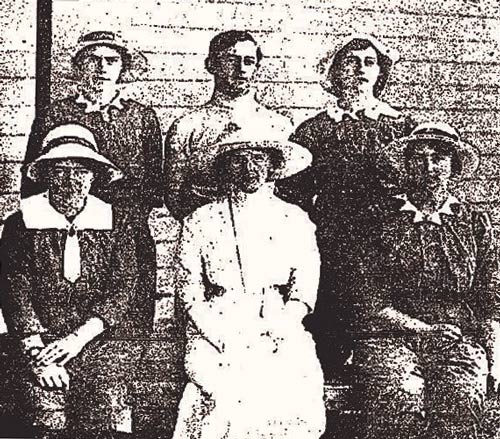
Warrnambool Ladies Rowing Club who competed at Albert Park: 1914
Miss Clothier, Miss Burke, Mr Buchanan (Cox). Miss Hives, Mrs Gill (Secretary), Miss Blevins.
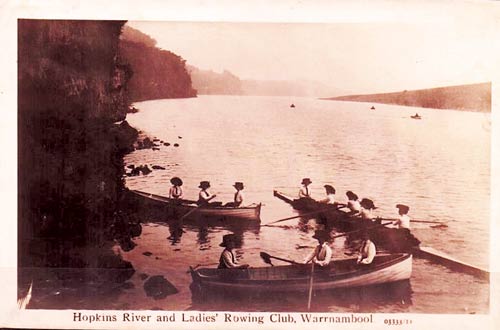
Warrnambool Ladies Rowing Club crews on the Hopkins, no date.
The Club, in virtual recess, did however have its traditional ‘opening day’ of the 1914 season on November 14. It was held in conjunction with the Ladies’ Club who took the opportunity of christening their recently purchased pair-oar boats. Miss Murray, Vice President, named the boats ‘Lyndoch’ and ‘Waikato’ and wished the Club a ‘full measure of success’. As their opening event the Ladies Club had the Lyndoch Pairs. This event was also well contested and resulted in Messrs M. Day and D. Williamson passing the post first. This race started at the Lyndoch boatshed and the finishing post was the Rowing Club’s shed. Mrs G. Rolfe donated the trophies for both events. The depleted Warrnambool Rowing Club competed for the Lyndoch Fours. The course was from the bridge to the sheds and was won by H. Jenkins’ crew from W. Hopes’ crew. 86 87
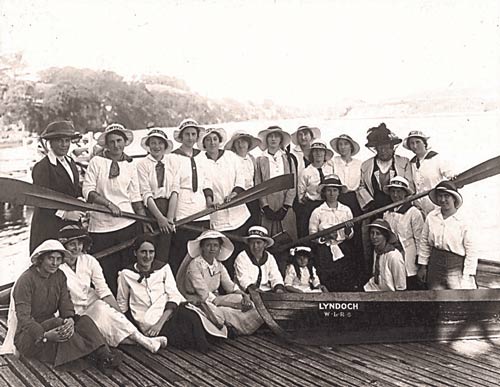
Warrnambool Ladies Rowing Club: 1914
Members beside the ‘Lyndoch’ their new pair oared boat.
The Warrnambool Rowing Club held races on the Hopkins on Boxing Day, attracting a large number of spectators along the course from the bridge to the boatsheds. The rowing events consisted of the Cantor Pairs, an ‘ex members’ race and the Rogers Sculls. Saturday's program also included an event for ladies and a couple of swimming races organised by the Lady Bay Swimming Club. Mrs E. Frawley presented the trophies to the members of the winning crews in the ladies events.
In March 1915 there was an Aquatic carnival on the Hopkins River. 88 Events included rowing, swimming and perhaps unusually, a goat race. The course for the ladies’ events was from Lyndoch jetty to Dallimores jetty. Proceeds were donated to the Belgian Fund. 89
By now every eligible Club member had volunteered to enlist for the war. The rowers who did not return were Edward Artso, F. Roy Chapman, Timothy M. Dwyer, Leo P. Gartlan and H. Thompson. Private Edward Harold Artso was a carpenter who enlisted at age 23, having been previously rejected for being too short. He was only 5 feet 2 inches tall. Edward received gun-shot wounds to his back and right arm whilst serving with the 29th Battalion near Morlancourt, France. He subsequently died from these wounds on May 18 and was buried at the British Cemetery at Vignacourt on May 25 1918.
Sapper Frank Roy Chapman was an unmarried blacksmith who enlisted at 20 years of age. He served in Egypt and Palestine, dying in Gaza of malaria and bronchitis on October 28 1918. Not much is known of Roy other than he was a signaller of the first signal troop with the Australian Engineers. Also he obviously was not one for taking orders well. He was disciplined for disobedience and being absent without leave for a few hours early in his overseas service.
Private Timothy Michael Dwyer was a 22 year old road contractor from Kirkstall who enlisted in April 1916. He rose to the rank of Lance Corporal on February 5 1917 and was killed in action on April 11 1917 near Bullecourt in France. He was with 46th Battalion who were part of the first Bullecourt Battle. The 46th lost nine officers and 364 other ranks in this battle. He has no known grave - his name is recorded on Villers-Bretonneux Memorial, France.
Gunner Leo Patrick Gartlan had been a cabinet maker at the Warrnambool Furnishing Company, when at age 21 he enlisted. Leo saw much action and was wounded in action on November 4 1916 with a ‘mild’ gun-shot wound to the head. He recuperated in England before returning to the front in June 1917. He was killed in action as he carried lights during an evacuation in France on August 18 1917. His grave was lost in subsequent fighting and his name is recorded on Ypres Memorial, Belgium.
Private Harold George “Jack” Thompson, was killed in 1918. He was formerly a grocer’s assistant at Swinton’s and the Club cox, succeeding one of his brothers. He had steered his crew to win the Colac Junior Fours in 1915.When war broke out he was in the Navy and had been pensioned after an injury. He rescinded his pension and enlisted. As he was under 18 years of age he needed his parents’ consent. His four brothers had also enlisted.90 91
These five men are among the 320 Victorian Rowing Association members whose names are recorded on the Oarsmen’s Cenotaph, located next to the Yarra River in Melbourne’s Alexandra Gardens. A wreath-laying ceremony was held in February 2013 at the Melbourne Oarsmen’s Cenotaph, to mark its recent refurbishment.92 Club members listed as served were G. Butler, P. Curtis, V. Flett, W. Hope, K. McDougall, S. Murphy, J. O’Donnell, C. F. Robinson and W. Saril.93
At the Club’s 1915 Annual General Meeting it was reported that although the Club was financially sound, rowing was practically at a standstill, due to the war. Boat Captain Mr Foyle read his annual report:
"In submitting my report to you I must mention the war, which had just broken out when our last annual meeting was held and has affected rowing as all other sports almost to the point of extinction of both. Members and ex-members have left for the front, several of whose names have appeared in the casualty lists”.
The only regatta attended that year was Colac. The Boxing Day Regatta was abandoned. The sum of £1/1 was voted to the local appeal for the Australian sick and wounded soldiers. At the conclusion of the meeting a minute of appreciation was placed on the books for the services rendered to the Club by the late Mayor, Mr Landmann.94
Some regattas continued during WWI and as mentioned above, the Colac Regatta was one of them. At the 1915 Colac Regatta, Warrnambool won the Junior Four with a crew comprising E. Jenkins, A. J. Fisher, W. Hope, H. Jenkins and cox H. G. “Jack” Thompson. As mentioned Jack Thompson was under 18 years and regrettably died in service in 1918.
In 1916 Warrnambool was successful in the Junior Pair with W. Hope, H. Jenkins and cox S. Palmer.
There were two wins in 1917 with the Maiden Four of R. New, T. Tinker, C. Jackaway and stroke B. Proudfoot and the Lightweight Maiden Four of E. Jackaway, V. Sheriffs, C. Mitchell and D. Spottswood.
Lance Corporal McDougall, a Life Member of the Club who had been one of the first members to enlist, returned home in August 1916. The total number of rowers serving at this time was now 43.95 A motion, expressing members' regret at the death of Pte. T. Dwyer, killed in action in France, was recorded in meeting minutes.96
The opening of the 1916-17 season was marked by the planting of a Memorial Norfolk Pine to perpetuate the memory of a former member, Major Thomas (Tom) Harold Redford of the 8th Light Horse. Tom was the third son of Thomas Redford (1841-1909) who was a merchant (‘purchaser of descriptions of colonial produce, including sheepskins, wool and tallow’)97 and a Warrnambool Councillor from 1884-90. The building on the corner of Timor and Fairy Streets was known as Redford’s Corner. Thomas (snr) and his family lived at "Wildwood", now the location of Wildwood Crescent. Tom attended Warrnambool College for nine years and was a member of the Warrnambool Rowing Club, Racing Club and a Captain of the Warrnambool Cricket Club. He was married and living in Sydney when he enlisted and embarked from Melbourne in February 1915 on the ‘Star of Victoria’, arriving at Gallipoli in May. He was killed in action at The Nek on August 7 1915, as the Australians prepared to charge the Turkish trenches. The charge was depicted in the last minutes of Peter Weir’s film Gallipoli. Tom’s body was reinterred at the Walkers Ridge Cemetery, 1200 yards N.E. of Anzac Cove, Gallipoli.98 The Mayor, Cr. Webb, made a speech when the commemorative tree was planted expressing the hope that the tree would remain as a memorial to the “brave deeds performed at Gallipoli” and that the tree would serve to commemorate the part taken by the Club in the ‘great struggle’.99 100 The Hamilton Spectator reported the news of Tom’s death, ‘one of nature’s gentlemen, prominently known locally in the cricketing field’ and that ‘all available flags’ were at half-mast’.101 The Redford family grave is at the Warrnambool Cemetery.
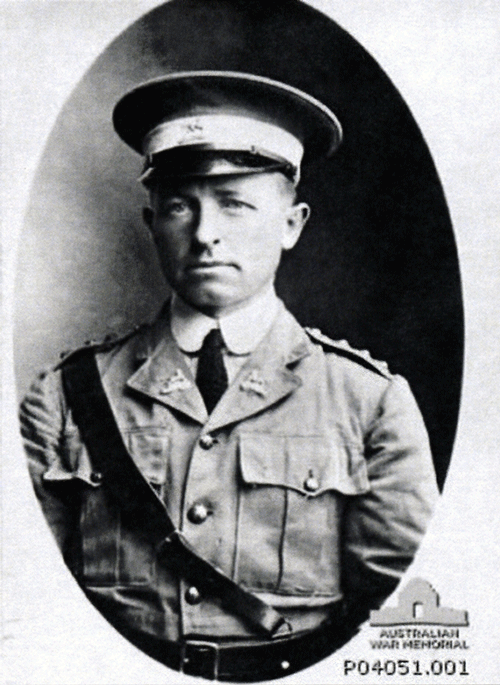
Major Thomas "Tom" Harold Redford
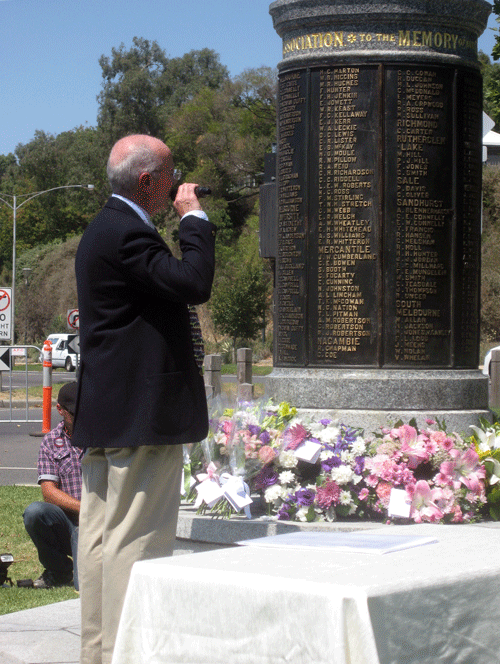
WWI Oarsmen's Cenotagh on the Yarra River, Melbourne 2013
Rowing Victoria President Andrew Guerin reads the names of those rowers who were lost in WWI at the re-dedication ceremony
That November evening an Honour Roll was unveiled at Anderson's Café in the presence of a large number of' members and friends. The Mayor said that he had seen it mentioned that the rowing clubs of Victoria had supplied over a thousand men to the war effort. Whilst rowers as a whole had done their share, the Warrnambool Club had achieved a record that could not be surpassed, every member of military age volunteering. He admired the principle of each Club and association erecting Honour Rolls. The Mayor withdrew the Union Jack which had been draped over the Honour Roll, made by Miss Ray Grayson. It was surmounted by the words 'Lest We Forget Honour Roll of Members and ex-Members.' On either side of the space containing the names were national flags, the Union Jack on one side and the Commonwealth flag on the other. The names are as follow: C. F. Robinson, S. Murphy, K. McDougall, A. Thompson, J. Thompson, W. Hope, P. Curtis, R. Chapman, G. Butler, V. Flett, E. Artso, L. Gartlan, T. Dwyer, J. O'Donnell F. Richter, C. Humphreys, K. Foote, A. Cordner, M. McKay, St. McKay, S. Brown, A. Anson, A. Collins, W. Beeching, C. Fisher, L. Marfell (Lieut.), W. McKenzie, F. Flett, W. Webb, T. Redford (Major), L. Parsons, W. J. S. Davidson (Major), B. Chew, W. Archibald, W. McGee (Captain), R. Titford, D. London, 0. Willimson, C. Flett. R. Fisher J. Levy, C. C. Macknight (Major), C. King, R. Lee, W. McLennan. S. Mitchell, H. Roper, G. Fary, W. Mackinlay, G. Robinson, H. Harris, J. Brown, J. Granter, J. Beeching, R. Dickson. T. Baillie and M. Battarbee.102 103 In 1918 Club members returning from fighting in the war were presented with Gold Medals by the Club.
In August 1918 at the annual meeting the Club’s President Cr. F. J. Gill reported that the season commenced with a credit balance of £8 5/1. The Club Captain Mr E. Jenkins, reviewed the activities of the past season, and added the war has taken a further toll of members and ex-members with Messrs L. Gartlan, E. Artso, H. Thompson, T. Dwyer and Mr J. Levy, an ex-member, not returning (R. Chapman died in October 1918). One active member, Mr C. Robinson, and one ex-member, Mr H. Ropor, succeeded in gaining the distinction of being awarded the Military Medal. Lieutenant Colonel Davidson, an ex-Captain of the Club, had returned to Australia after being awarded the Distinguished Service Order. The Captain urged members to keep the Club together until the return of ‘the boys’ from the front.
The Club planned to take a four-oared boat, manned by a crew in the Club’s colours, to Market Day held to commemorate the proclamation of Warrnambool as a City.104 Daniel Thompson was in a Warrnambool crew that won an under 20 four, the medal is inscribed: ‘NAR under 20 Four, 1918’.105
There was a Boxing Day Regatta in 1918 in an attempt to revive the annual event. The day was like a carnival with events including rowing, Miss Hopkins, Miss Junior Hopkins, swimming, boxing, highland dancing, boomerang throwing, decorated boats and band recitals.
Not everybody who used the river could swim and in December 1919 two quick thinking and brave rowers sighted a near tragedy. Les Palmer and Daniel Thompson rescued Millicent Mary Gray, 18 years, and Andrew Gordon Sloane, 20 years, from drowning when their boat started in sink. They were awarded a Royal Humane Society medal for bravery. They went to Melbourne on the steamer ‘Casino’ to be presented with the award on April 8 1920. 106
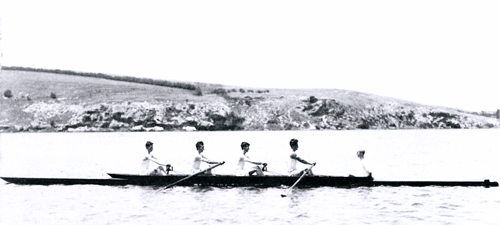
Warrnambool Men’s Four, Winners Lightweight Four: 1920.
Les Palmer (bow); S. Tinker (2); E. Tinker (3); T. Anson (str) and C. Riches (cox).
It appears the Club waned with the effect of the war further reducing numbers and momentum however by 1921 efforts were being made to regroup. The President of the Warrnambool Rowing Club made application to the VRA for official reinstatement of the Warrnambool Boxing Day Regatta, to be rowed as a ‘double’ with the Colac Regatta. When the regatta was sanctioned in 1915, and abandoned due to the war, it was understood that only Western District and Ballarat Clubs would take part so it did not impact on Nagambie, the traditional holder of a Boxing Day Regatta. 107 This explains why Warrnambool Boxing Day Regatta was not an ongoing success. As transport improved clubs could go to the larger Nagambie Regatta, one of the longest running regattas in Victoria. The 1921 regatta program included rowers who went on to success. These included former footballer Colin Watson who was the second Brownlow medalist. Russell Cohen was a solicitor and Melbourne University athlete who stroked the MUBC Eight to win the Grand Challenge Cup at Henley on Yarra in 1924. Bryan Keon Cohen was a surgeon and successful rower with Melbourne University. Bill Grose became Barwon’s Captain, holding the office for 30 years. Stan Neal coached Hawthorn Rowing Club until he retired in 1970. Jack ‘Jop’ Jopling stroked the Victorian Kings Cup race in 1924 and 1925 and 10 state titles with Wendouree.108
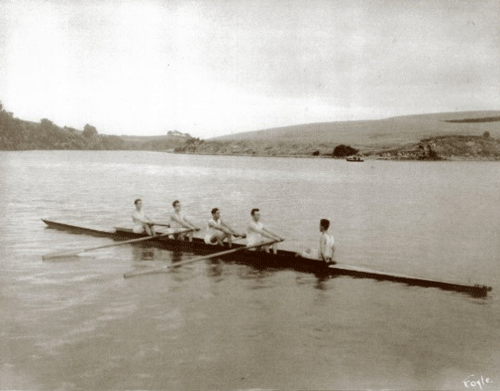
Lightweight Four, Winners Barwon Regatta: 1925.
Bow: L. Halliwell, 2: C. Earls, 3:J. MacNamara, str: H. Sherrif, cox: T. Far
Finally in 1923 the Warrnambool Regatta was held in ‘cool’ conditions, with some crews not finishing the course.109 This implies it was very windy and perhaps a terrible day for rowing. In 1924, the Club hosted a more successful Boxing Day Regatta. Reports included comment about the wide river and its ability to host a race of eights with six to eight boats abreast eliminating the need for heats. The regatta was described as a ‘spectacular sight’ and was enjoyed by all. To attract clubs to its regatta, Warrnambool offered a refund of half freight to competing clubs and assisted in the unloading and reloading of boats near the river, where the train would stop near the Simpson Street Bridge to allow unloading of the boats.110
The Club’s annual ‘opening day’ in November 1926 was also celebrated as the 40th year of the Club’s existence. Two of the pioneer members, Captain A. S. Brown and Arthur Anson, were present. Nine crews competed in the afternoon events. The ‘Lyndoch Fours’ were won by stroke C. Jackman, J. Down, A. Struth, and bow G. Fary.111
The Club’s President from 1925-1927 was Mr Martin Lucas Carter (‘Marty’) who ran a saddlery business in Fairy Street and had been the Mayor of Warrnambool in 1923, when the breakwater and harbour was being discussed. He had many sporting and civic interests including scouts, the Progress Association, and held executive positions with the City Band, for 53 years.
In 1926 the Club purchased two pair oared boats from Ballarat for £15. Delivery was complex as the boats had to be delivered to Melbourne where they were placed aboard a ship bound for Warrnambool.
On August 8 1927 the Warrnambool Rowing Club Ball was held in the Town Hall and was reported as:
“..gay with ropes of coloured electric lights, gum saplings, and streamers, into which were introduced crossed oars and other emblems of the Club. A maypole canopy of coloured streamers and electric bulbs graced the supper room, where the tables were a delightful blend of Iceland poppies, leptosome daisies, and wattle blossom, with the blue ribbons of the Club in dainty contrast”.
Among the many present were Mr M. L. Carter President, Mr F. J. Gill Vice-President and Mrs H. B. Randall Captain of the Ladies' Club, who wore a “graceful frock of old rose satin and floral georgette”. The newspaper reported the dresses and attendance of over 50 other ladies.
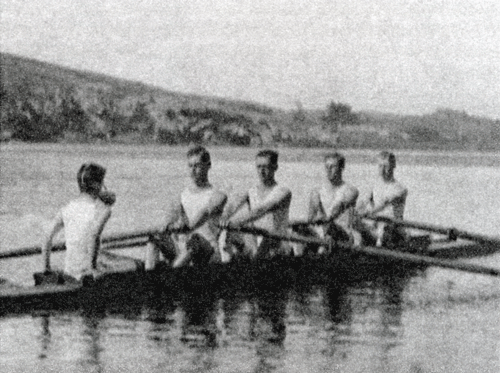
Winners Maiden Fours - Warrnambool and Colac Junior Fours - Ballarat: 1926-27.
Cox with megaphone R. Gibbons, str: D. Owen, 3. L. Lloyd, 2. C. Dodds and bow J. Down. Coach T. Anson.
Infrastructure improvements along the bank were needed. In 1928 the Minister of Lands notified the Warrnambool Town Council that a grant of £200 had been made for improvements along the Hopkins River. A permit was issued giving permission to build a ladies’ rowing shed, alongside the men’s two storey shed.112 Extra landings were also built to ease congestion during regattas. The 1928 regatta, held on Easter Saturday, was attended by the Warrnambool Ladies’ Rowing Club and three schools, who provided the pairs for the events. The regatta included the ‘Head of the River’ and the ‘Mayor’s Pairs’. At a Club meeting a motion was passed that ‘card playing’ in the rowing shed be no longer allowed.113
Everything was going well for the Club. The 1929 Warrnambool Boxing Day Regatta was expected to be another successful event. The program consisted of Maiden Pairs, Maiden Fours, Maiden Eights, and Light weight Pairs, Lightweight Fours, Lightweight Eights, Junior Pairs, Junior Fours, Junior Eights, Ladies' Fours and Warrnambool inter-collegiate Fours. The Club’s Secretary, Mr W A Hope, expected a good entry from Western District Club’s and several crews from Melbourne to compete.114
In 1929 membership fees for current members increased to £1/10 ($3) and the fee for new members remained at £1/1 ($2.10). However, by 1930 the effects of the global depression were being felt across Australia and in 1931 the Federal basic wage was cut by 10%. Members of the Warrnambool Rowing Club voted to help paint the Ladies Rowing Club shed.115 The only high point for the nation was the Sydney Harbour Bridge opening in 1932. It was reported in 1933 that Warrnambool was competing at the Rutherglen Regatta.116
The Club’s regatta transport was now sorted with a bus used with boats transported atop.
Warrnambool Bus Lines owned the bus and added timber struts to the front and back bumper bars with most of the boat length being kept to the front. With these modifications the bus could not feasibly be used for anything else and so became the ‘Club’s Bus’. Snow Dodds, who worked for the Bus Lines and was the brother of rower Charlie Dodds, acted as regatta driver. Previously boats had been sent on a truck or by train with members carrying the boats up to the Railway Bridge, struggling up the embankment to where the train would stop to enable loading. 117
Club membership increased through the efforts of Mr Max Armstrong, a rower, who was a grandson of a Eureka miner. He moved to Warrnambool in the 1930’s and helped in the family’s footwear business before moving on to run ‘Shoe Mart’ in Collins Street Melbourne. There he rowed with Banks and army crews. He led the mounted horsemen in the Anzac Day parades to the Shrine of Remembrance for many years. Many Australians, including women in the 1956 Olympic team, clad their feet in his footwear.118
The Club was invigorated with a full committee elected in 1935. Meeting minutes included mention of a sweep on the Flemington Steeplechase in July with a three pound prize ($6).119 Some clubs elected not to be affiliated with rowing’s state body the ‘Victorian Rowing Association’ (VRA) and the Club had at times opted in and out. In 1935 re affiliation of the Warrnambool Rowing Club was agreed.120 There were 26 Club patrons listed, iconic names included Philpott, Fletcher-Jones, Younger, Tait, Brauer, Ecker, Sambell, Rodgers and Ardlie. The Club changed its colours to pale and navy blue.121
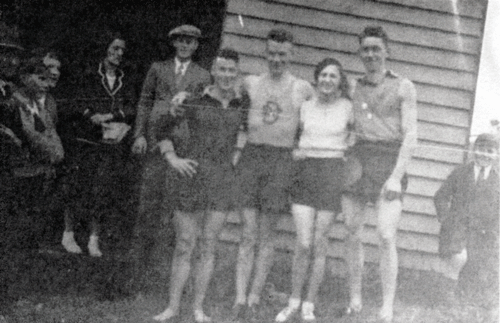
Winner of Combination Four:1936
Str: Clive Beattie, 3: Eric Richmond, 2: Enid Edmund, bow: Bill Saddler
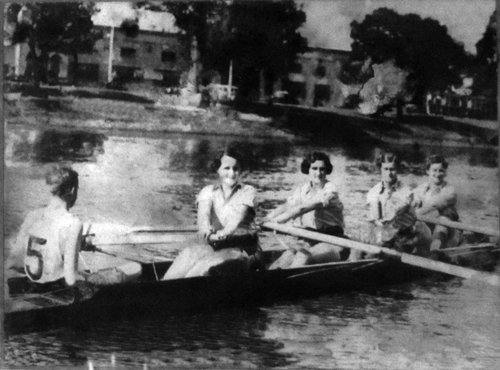
Warrnambool Ladies Rowing Club, Maiden Four: 1936-1937
Cox: Ron Dodds, str: Margaret McDonald, 3: Isabella MacNamara, 2: Marge Edmonds, bow: Eunice Jessen. Marge and Isabella were noted to smoke cigarettes and drink ‘beer from a glass’.
In 1936 the men’s and ladies’ Clubs held a combined regatta on the Hopkins.122 In 1937 the men’s Club renamed two fours the Belvedere and Tooram.123 A men’s four entered the November 1936 Henley on the Yarra River. The crew was Fred Toohey, R. Jessen, H. Everard, C. Beattie with F. Hazlewood as stroke and Roy Scutcheon cox. Results are unknown however the Club competed at subsequent Henleys on the Yarra.
Tension between coaches emerged in 1939. A motion was carried that Roy Scutcheon draw up a plan for coaching on Fairbain style and such plan to be universally adopted by all Club coaches.124 A subsequent motion that the R.G. Merriman’s style of rowing be adopted, was amended to ‘coaches coach each in his own style with certain limitations’.125
Ron Merriman, previously a rower with Wendouree, coached at Warrnambool from 1938-1948. He was a member of the Wendouree Senior Eight which won the Victorian Eight Oared Titles in 1923, 1924 and 1925. In 1924 he rowed in the 2 seat of the Wendouree Club Eight which represented Victoria in the Kings Cup in Adelaide. This crew was leading in the first half of the race, when it was swamped by the wake of a motor boat. In 1927 Ron rowed in the Senior Four, representing Australia in New Zealand regattas, winning at Wanganui and Wellington.126 Ron’s two sons rowed for Warrnambool, George and Ron (Jnr.). George was also a good runner and competed in a couple of Stawell Gifts.
There was a delay in receiving a new set of oars in 1938 due to the shortage of suitable spruce timber.127Boats in the shed were insured and included (with its value) - Lyndoch (eight) £100, F J Gill (racing four) £50, G Eaton and P Cram (practice fours) £100, two practice pairs £50, twenty oars £40, and the building £210.128
In 1939 there was a motion to change the Club colours to a maroon singlet with white knicks.129 This must not have been adopted as the pale blue (without the navy blue) continued to be worn until 1953.
Membership fees increased to £2/10 ($5.00) and remained at $5.00 until 1975.
A rower who enlisted in WW2 was Edward Charles (Ted) Owen. He was John Henry Owens twin and they were born in 1916. Together they won the Novice Pairs in 1939 on the Hopkins River. Edward joined the AAF after initially being told he was too old to fly, he was 22 years old and it was understood that 18 year olds were more daring and were therefore preferred. He piloted Lancaster bombers and on his 50th flight came under fire. A bullet went thru the windscreen and into his face. He was treated however refused sedation or pain relief as he was the only person who could land the plane. He won the Distinguished Flying Cross.130
An incomplete list of rowers who served is listed on the Rolls of Honor include J.A. Campbell, C. E. Dodds, R. A. Dodds, R. Gibbons, J.B. Homer, D.R. Lark, Les. E. Sheedy and H. Sherrif.
With the Second World War in full swing and membership falling the future of the rowing club was discussed. It was decided to sell the Club shed for removal and store the Clubs boats in the ladies shed, for the duration of the war. The boat shed was sold in 1940 to the Boys’ Club for £63 and was re sited on a block of land on the corner of Henna and Lava Streets131. In 1945 single women and widows were called up for the Women’s Services, the Women’s Land Army and for War Industry. There were less people and money for sport. Finally in August 1945 the war ended.
Footnotes
79 Warrnambool Standard, 29th September, 1914. Page 3.
80 The Colac Herald, 30th September, 1914. Page 5.
81 Warrnambool Rowing Club Minute Book 1914-1935. pp 3-4.
82 Warrnambool Rowing Club Minute Book 1914-1935. pp 5-9.
83 http://trove.nla.gov.au/ndp/del/article/73552743?searchTerm: Warrnambool rowing&searchLimits: Warrnambool Standard 17th October 1914.
84 Punch, 8th January, 1914. Page 26.
85 Punch, 29th January, 1914. Page 19. http://trove.nla.gov.au/ndp/del/article/129696844.
86 Warrnambool Standard, 16th November, 1914. Page 5.
87 Warrnambool Rowing Club Minute Book 1914-1935.
88 http://trove.nla.gov.au/ndp/del/article/73563793?searchTerm=Warrnambool rowing&searchLimits: Warrnambool Standard, 2nd March, 1915.
89 ‘Aquatic Carnival’, no author, Warrnambool Standard, 6th March 1915. Page 2.
90 National Archives of Australia and Australian War Memorial- websites.
91 ‘For King and Country – Great War Enlistments from Warrnambool and District. Blair, R. & Affleck, James. Entries A-T. No page numbers.
92 ‘Dropping oars for king and country’, Himmelreich, Everard. Warrnambool Standard, 20th April, 2013.
93 The Oarsman’s Cenotaph 1923, Alexander Gardens, Melbourne, Victoria, Australia.
94 http://trove.nla.gov.au/ndp/del/article/73456772?searchTerm=Warrnambool rowing&searchLimits: Warrnambool Standard, 21st August, 1915.
95 http://trove.nla.gov.au/ndp/del/article/73888603?searchTerm=Warrnambool rowing&searchLimits: Warrnambool Standard, 16th August 1916
96 http://trove.nla.gov.au/ndp/del/article/73937162?searchTerm=Warrnambool rowing&searchLimits=Warrnambool Standard 17th August, 1917.
97 The Warrnambool Standard, 27th January, 1888. Page 1.
98 National Archives of Australia and Australian War Memorial- websites.
99 The Argus, 9th November, 1916. Page 4.
100 The Argus, 9th November, 1916. Page 4.
101 Hamilton Spectator, 23rd August, 1915. No page.
102 The Winner, 6th December, 1916. Page 8.
103 The Age, Wednesday November, 1916. Page 8.
104 http://trove.nla.gov.au/ndp/del/article/74034854?searchTerm=Warrnambool rowing&searchLimits: Warrnambool Standard, 17th August, 1918.
105 Oral History Brain Thompson telephone call with Susan Finnigan, 23rd December 2015.
106 Oral History Brain Thompson telephone call with Susan Finnigan, 23rd December 2015.
107 The Australasian, 4th June 1921. http://trove.nla.gov.au/ndp/del/article/140260132?searchTerm: Warrnambool rowing 1885&searchLimits.
108 ‘Hundred Years of Rowing at Warrnambool’, Todd, Ray. Warrnambool Standard, 24th October, 1973. No page.
109 The Argus, 27th December, 1923. Page 4.
110 The Argus, 6th December, 1924. Page 23.
111 The Argus, 10th November, 1926. Page 14.
112 The Age (Melbourne), 25th February, 1928. Page 20.
113 Warrnambool Rowing Club Minute Book 1914- 1935, General Meeting at Wattles Café, 12th March, 1928. Page 144.
114 Sporting Globe (Melbourne), 8th December, 1928. Page 6; The Age, 10th December, 1929. Page 15.
115 Warrnambool Rowing Club Minute Book 1914- 1935, General Meeting at Wattles Café, 9th January, 1930. Page 158.
116 The Argus, 3rd January, 1933. Page 2.
117 Oral History Des Tinker and Desmond Thompson/Susan finnigan 14th January 2016.
118 http://www.theage.com.au/national/shoe-man-a-shooin-onhorses20100328r55r.html#ixzz2g3GV204f
119 Warrnambool Rowing Club Minute Book 1914- 1935, Meeting at Eckers Hotel, 6th June, 1935. Page 177.
120 The Age, 5th December, 1935. Page 5.
121 Warrnambool Rowing Club Minute Book 1914-35, Ordinary Meeting at Scout Hall, 26th September, 1935. Page 179.
122 The Argus, ‘Champion Sculls’, 3rd February 1936. Page 4.
123 Warrnambool Rowing Club Minute Book 1935-1953, Ordinary meeting, 1st December, 1937. pp 25-26.
124 Warrnambool Rowing Club Minute Book 1935-1953, Ordinary meeting, 2nd November, 1937. Page 23
125 Warrnambool Rowing Club Minute Book 1935-1953, Ordinary meeting, 6th October, 1939. Page 45.
126 ‘Rowing’, Todd, Ray. Newspaper cutting, untitled, undated, no page number.
127 Warrnambool Rowing Club Minute Book 1935- 1953, Ordinary Meeting, 6th January, 1938. Page 27.
128 Warrnambool Rowing Club Minute Book 1935- 1953, Ordinary Meeting, 7th February, 1938. Page 30.
129 ‘Rowers Celebrating Clubs Centenary- Regatta on Hopkins ’no author, Warrnambool Standard, 10th October, 1973. No page.
130 Oral History Stewart Owen call with Susan Finnigan, 23rd December 2015
131 Warrnambool Rowing Club Minute Book 1935- 1953, Ordinary Meeting, 3rd December, 1940. pp 51-2.

